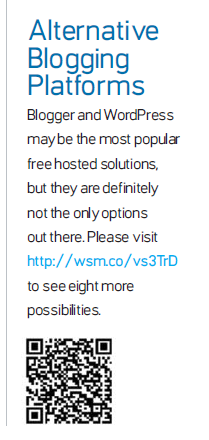Blogging on a Benjamin

Start blogging for your small business for less than $100
Whether you own a brick-and-mortar store or a Web-based company, blogs help small businesses reach out and engage a targeted audience. This fact is not lost on many, but for some, blogs may appear to be just another time and money investment on top of an already hectic workload.
While it does require a time commitment to make your blogging efforts worthwhile, it is entirely possible to start blogging without making a significant financial investment. In fact, it can be done for (way) less than $100 a year, and here's how:
Where to Start
Many solutions allow blogs to be hosted on the platform provider's server for free, providing a useful option for businesses that want to start blogging without breaking the bank. These platforms allow users to sign up and have a fully functional blog with an easy to understand, intuitive interface and not have to worry about paying to host or maintain it (e.g. security).
The most popular of these services are Google's Blogger and the WordPress.com platform (not to be confused with the open-source, self-hosted software from WordPress.org). There are many other options, however, including the increasingly popular microblogging platform Tumblr.
Make it Your Own
Some business owners may have concerns that these free platforms do not provide the professional look they want for their companies. Today's vendors recognize that blogs have to look appealing and, as a result, most of the major platforms come with a wide selection of themes and customization options to make a business blog more visually appealing - as well as incorporate the look and feel of a company's brand.
Blogger offers template customization that allows users to select from about seven different templates that are all highly configurable. Users have the opportunity to modify the main color themes and background images, adjust the width of the blog and alter its layout. Blogger also has more advanced options that let users choose the font style and sizes of particular sections of the blog and change individual colors of different text sections. Each template also provides the ability to add widgets, social media buttons, RSS feeds, email subscriptions, surveys, newsreels and more.
WordPress provides both free and paid downloadable blog themes that can also be customized. Users can choose from hundreds of free themes, review specific features and even access a visual preview of each theme. After activating one of these themes, users can customize them further by altering the headers, background and fonts of various sections, adding widgets and menus, optimizing for mobile and tablet devices and altering a page's CSS for full control over the presentation.
Total estimated cost so far: $0 - $45
 What's in a Name?
What's in a Name?
When first creating a blog on a free platform, it will be hosted under the provider's subdomain (i.e., sample. wordpress.com or sample.blogspot.com). But these companies also provide options for users to host their own domains, which may better allow your business blog to stand out in a crowd.
WordPress requires users to pay for an upgrade of $12 per year to use domains owned by the company. For $17 a year, users can register and map a domain through WordPress. Other providers such as Blogger and Tumblr will map domain names to blogs and allow users to purchase domains through them. In order to have a custom domain mapped on services like Blogger or Tumblr, users must edit the domain's CNAME records through the registrar where they purchased the domain.
The cost of a domain varies depending on what and where you register, but it generally ranges from $10-$40 a year - usually on the lower end of the scale.
If you already have a business website but are not yet blogging, the best option may be to integrate a new blog onto your own site. This method allows business owners to host a blog on their own server for little to no cost, and it will prevent visitors from having to leave the company's website to enjoy its content. This is easier to do with some platforms than it is with others, so it is important to check out each provider's integration functionalities before signing up.
Total estimated cost so far: $0 - $85
Get Busy, Make Money
Running a blog presents myriad possibilities for your small business' Web presence, but blogging also presents an opportunity to earn a profit. Although it may not be your main reason for starting a blog, every small business should explore each revenue stream they can - and blogging may prove to be a significant one.
There are many ways to monetize a blog, the easiest of which is by selling advertising space. Blogger can easily integrate AdSense - Google's monetization platform for publishers - because both platforms fall under Google's umbrella. Likewise, WordPress recently released WordAds, a similar platform that allows users to sell ad space on their WordPress blogs.
Remember that the primary reason to blog is to deepen customer relationships and increase referrals, and the first step is just to get your blog off the ground. Free hosted solutions provide you with this opportunity and allow you to get started in a way that won't have you constantly reaching for your wallet. With only the potential costs of a domain name, a premium theme if you choose, and perhaps some plugins for added functionality, establishing a professional blog can easily be done for under $100. So, what are you waiting for?
Grab a "Benjamin" and start blogging!










